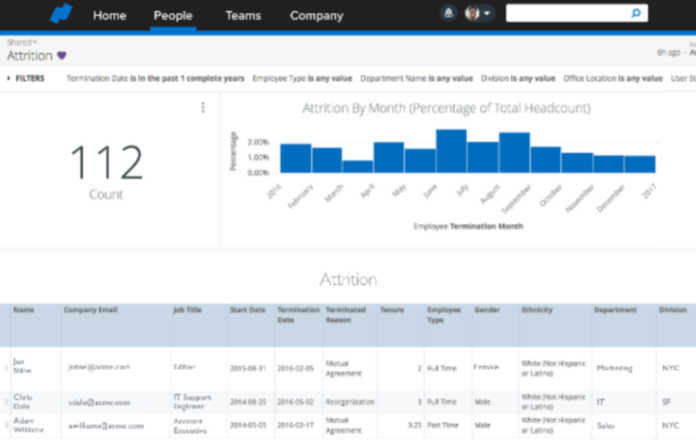
Namely announced a benchmarking package for mid-sized companies. The platform uses machine learning to search real-world scenarios that could impact workforce decisions, giving mid-sized firms some of the capabilities often used by enterprise firms.
Called HR Benchmarking, the platform looks at workforce and business scenarios that could impact employment dynamics such as attrition, retention and diversity. It indexes big data to extract insights, identify trends and distill business-specific intelligence for each client.
Employers can then make adjustments in their HR approach where necessary, based on data that reveals the reasons behind employee turnover, for example, or the need to train managers on issues such as conscious and unconscious bias.
Namely's Benchmarking helps employers tweak their HR approach based on data that reveals the reasons behind, say, employee turnover. Share on XEric Knudsen, Namely’s manager of people analytics, told Employee Benefit News that Benchmarking distills company turnover data and compares it to information from similar employers in Namely’s system. That data is taken from the company’s more than 1,000 customers and their 175,000 employees.
Namely said early results from HR Benchmarking uncovered unexpected workplace trends, such as:
- The top reason employees leave mid-sized technology companies is a lack of role clarity. More than 52 percent of tech professionals said this was a key cause of dissatisfaction and directly led to their departure.
- Teams led by managers with eight to 10 direct reports had the lowest turnover rates.
- The occurrence of “ghosting,” or employees abandoning their jobs, has doubled over the past year.
Analytics: Slow Momentum
Although LinkedIn says 71 percent of North American companies consider people analytics to be an important tool for making business decisions, only 22 percent are actually using analytics in HR. Meanwhile, research consistently shows that HR leaders lag behind other in their ability to drive a culture shift to data-driven decision-making. According to the Harvard Business Review, just 11 percent of business leaders trust HR to use data to fill their talent needs.
Whether Namely’s benchmarking will impact those numbers remains to be seen. But the product certainly is part of a gathering trend toward an expanded use of benchmarking by HR departments. With benchmarking, HR teams can more accurately do things like compare their company’s workforce to their competitors’ or identify patterns in employee exits and develop strategies to increase retention.
Perhaps stating the obvious, Nick Christman, Namely’s senior vice president of Strategy & Markets, observed that “all too often, HR teams are left to follow their gut and make assumptions on critical business decisions.” Namely’s benchmarking product should allow HR “to make an outsize impact on improving employee experience and creating an environment where talent can thrive,” he said.
We’ll see. In the short term, Namely’s extolling the benchmarking package’s simplicity, which it said will equip HR with business-specific information and data visualizations, which will guide their decision-making and strategy development.
Sign up for our newsletter here.
Image: Namely















